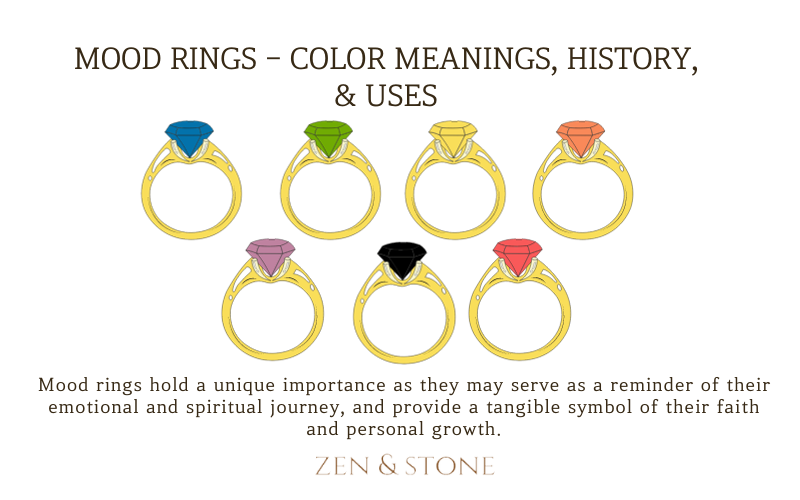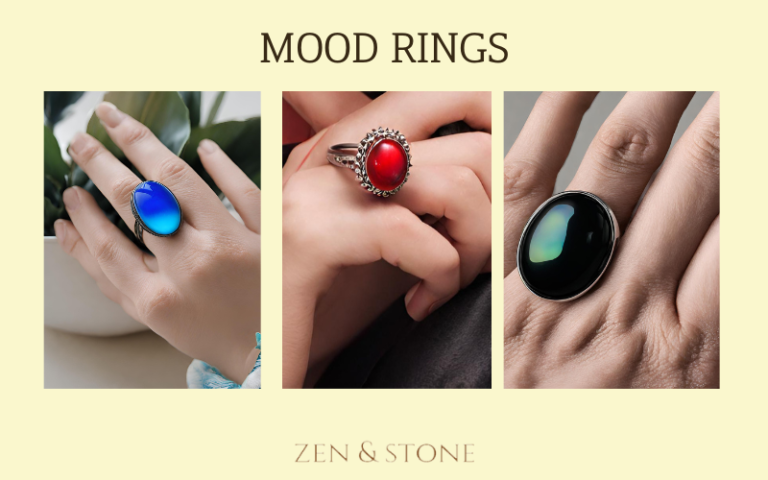
14 Nov Mood Rings – Color Meanings, History, & Uses
Mood rings are a fascinating piece of jewelry that changes colors based on the wearer’s body temperature. The concept behind mood rings is that different colors represent different moods or emotions. Many people believe that mood rings can provide insight into their emotional state, making them a popular accessory.
The history of mood rings dates back to the 1970s when they were first introduced as a novelty item. The rings gained popularity quickly and became a fashion trend. Today, mood rings are still popular, and many people wear them as a way to express their emotions or as a conversation starter.
Understanding mood ring colors is essential to interpreting their meanings. The colors of a mood ring can range from black to violet, with each color representing a different emotion or mood. It is important to note that mood ring colors are not an exact science, and different people may interpret them differently. However, understanding the general meanings behind each color can provide insight into the wearer’s emotional state.
Key Takeaways
- Mood rings change colors based on the wearer’s body temperature and are a popular accessory.
- The history of mood rings dates back to the 1970s when they were first introduced as a novelty item.
- Understanding mood ring colors is essential to interpreting their meanings.
Understanding the History of Mood Rings
Mood rings were first introduced in the 1970s and became an instant sensation. The first mood ring was invented by Maris Ambats and Josh Reynolds in New York in 1975. The rings were made of a thermochromic element, which changed colors based on the temperature of the wearer’s finger. The idea was that the ring color would reflect the wearer’s emotional state, as body temperature is known to change in response to emotional changes.
The original mood rings had six to seven colors, listed from least positive to most positive emotions: black, gray, yellow, green, blue, and violet, sometimes with a seventh color like reddish-brown or another shade of blue. Today, there are mood rings with all sorts of colors and associated emotions.
Mood rings were a popular fashion accessory in the 1970s and have remained popular ever since. They have been marketed as a way to monitor one’s emotional state and as a conversation starter. However, it is important to note that there is no scientific evidence to support the claim that mood rings can accurately reflect one’s emotions. The color changes in mood rings are simply a result of temperature changes and do not necessarily correspond to any specific emotions.
Mood Ring Colors
A mood ring is a piece of jewelry that changes color based on the wearer’s emotional state. The colors of a mood ring are believed to represent different emotions, and understanding the meaning behind each color can help you interpret your own moods.
Here are some common mood ring colors and their meanings:
- Blue: Calm, relaxed, and at ease
- Green: Happy, content, and peaceful
- Yellow: Nervous, anxious, and excited
- Orange: Energetic, adventurous, and enthusiastic
- Red: Passionate, angry, or stressed
- Purple: Romantic, creative, and imaginative
- Black: Stressed, tense, or overwhelmed
- Brown: Restless, agitated, or distracted
- Gray: Anxious, worried, or uncertain
- White: Bored, tired, or neutral
It’s important to note that mood ring colors aren’t an exact science. The colors can vary based on a number of factors, including the wearer’s body temperature and the lighting in the room. Additionally, different manufacturers may use slightly different color charts, so the meanings of the colors may vary slightly from one mood ring to another.
Despite these limitations, many people find mood rings to be a fun and interesting way to track their emotional state. By paying attention to the colors of their mood ring throughout the day, they can gain a better understanding of their moods and emotions.
Interpreting Mood Ring Meanings

Mood rings are believed to change color according to the wearer’s mood. The colors of the mood ring are associated with different emotions. The following are some of the most common mood ring colors and their meanings.
Black
A black mood ring color usually indicates that the wearer is feeling tense or nervous. It can also indicate that the crystal inside the ring is broken.
Blue
A blue mood ring color indicates that the wearer is feeling relaxed, calm, and at ease. It can also indicate that the wearer is experiencing strong emotions.
Green
A green mood ring color indicates that the wearer is feeling average or calm. It can also indicate that the wearer is experiencing a sense of balance and harmony.
Yellow
A yellow mood ring color indicates that the wearer is feeling excited or anxious. It can also indicate that the wearer is experiencing a sense of anticipation.
Red
A red mood ring color indicates that the wearer is feeling passionate or intense. It can also indicate that the wearer is experiencing a sense of urgency.
Purple
A purple mood ring color indicates that the wearer is feeling very happy and excited. It can also indicate that the wearer is experiencing a sense of passion and romance.
Factors Affecting Mood Ring Colors
Several factors can affect the colors that a mood ring displays. Here are some of the most significant:
1. Body Temperature
Mood rings change color in response to temperature changes, which means that the wearer’s body temperature can affect the ring’s color. If the wearer’s body temperature increases, the ring may change to a warmer color, while a decrease in body temperature can cause the ring to change to a cooler color. However, it’s important to note that mood rings are not precise thermometers and should not be used to measure body temperature.
2. Ambient Temperature
The ambient temperature can also affect the colors that a mood ring displays. If the temperature around the ring is warm, the ring may change to a warmer color, while a cooler ambient temperature can cause the ring to change to a cooler color.
3. Emotional State
While mood rings are not reliable indicators of emotional state, they can be influenced by the wearer’s emotions. For example, if the wearer is feeling happy or excited, the ring may change to a warm color like yellow or orange. On the other hand, if the wearer is feeling anxious or stressed, the ring may change to a cooler color like blue or green.
4. Quality of the Ring
The quality of the mood ring can also affect the colors it displays. Cheap or poorly made rings may not be as sensitive to temperature changes, leading to inaccurate color changes. Additionally, the materials used to make the ring can affect its performance. For example, a mood ring made with a metal that conducts heat well may be more accurate than one made with a poor conductor of heat.
How to Care for Your Mood Ring
Taking care of your mood ring is important to ensure its longevity and accuracy. Here are some tips on how to care for your mood ring:
- Keep your mood ring away from water, as it can damage the crystal and affect the accuracy of the color changes. This includes swimming, showering, and washing your hands while wearing the ring.
- Avoid exposing your mood ring to extreme temperatures, such as leaving it in direct sunlight or in a hot car. This can also damage the crystal and affect the color changes.
- Store your mood ring in a cool, dry place when not in use. Avoid storing it in direct sunlight or in a humid environment.
- Clean your mood ring regularly with a soft, dry cloth to remove any dirt or debris that may accumulate on the surface. Avoid using harsh chemicals or abrasive materials that can scratch or damage the crystal.
- If your mood ring has a metal band, be sure to polish it regularly to maintain its shine and prevent tarnishing.
- By following these simple tips, you can ensure that your mood ring stays in good condition and accurately reflects your mood and emotions.
Conclusion
In conclusion, mood rings can be a fun and interesting way to track changes in body temperature and potentially gain insight into one’s emotional state. While the science behind mood rings is not necessarily accurate or reliable, the meanings and associations with different colors can still be entertaining to explore.
It is important to note that the meanings of mood ring colors can vary depending on the manufacturer or source. However, some common associations include violet or purple for passion and excitement, blue for calmness or relaxation, and black or gray for tension or nervousness.
Ultimately, the interpretation of mood ring colors should be taken with a grain of salt and not relied upon as a definitive measure of one’s emotional state. However, for those interested in exploring the world of mood rings, it can be a fun and unique experience.

Sorry, the comment form is closed at this time.